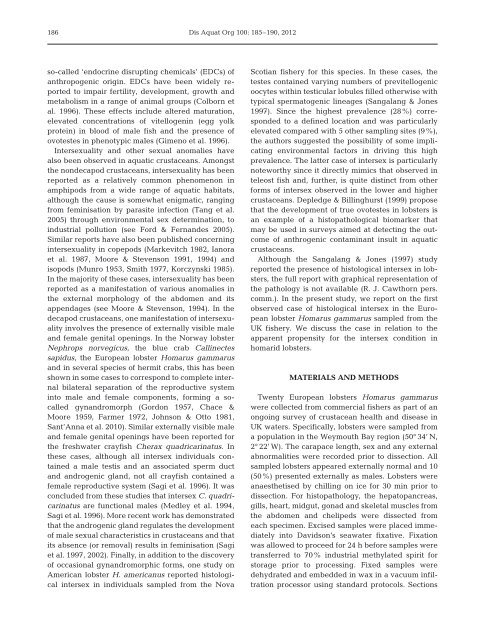Histological intersex (ovotestis) in the European lobster Homarus ...
Histological intersex (ovotestis) in the European lobster Homarus ...
Histological intersex (ovotestis) in the European lobster Homarus ...
Create successful ePaper yourself
Turn your PDF publications into a flip-book with our unique Google optimized e-Paper software.
186<br />
Dis Aquat Org 100: 185–190, 2012<br />
so-called ‘endocr<strong>in</strong>e disrupt<strong>in</strong>g chemicals’ (EDCs) of<br />
anthropogenic orig<strong>in</strong>. EDCs have been widely re -<br />
ported to impair fertility, development, growth and<br />
metabolism <strong>in</strong> a range of animal groups (Colborn et<br />
al. 1996). These effects <strong>in</strong>clude altered maturation,<br />
elevated concentrations of vitellogen<strong>in</strong> (egg yolk<br />
prote<strong>in</strong>) <strong>in</strong> blood of male fish and <strong>the</strong> presence of<br />
ovotestes <strong>in</strong> phenotypic males (Gimeno et al. 1996).<br />
Intersexuality and o<strong>the</strong>r sexual anomalies have<br />
also been observed <strong>in</strong> aquatic crustaceans. Amongst<br />
<strong>the</strong> nondecapod crustaceans, <strong><strong>in</strong>tersex</strong>uality has been<br />
reported as a relatively common phenomenon <strong>in</strong><br />
amphipods from a wide range of aquatic habitats,<br />
although <strong>the</strong> cause is somewhat enigmatic, rang<strong>in</strong>g<br />
from fem<strong>in</strong>isation by parasite <strong>in</strong>fection (Tang et al.<br />
2005) through environmental sex determ<strong>in</strong>ation, to<br />
<strong>in</strong>dustrial pollution (see Ford & Fernandes 2005).<br />
Similar reports have also been published concern<strong>in</strong>g<br />
<strong><strong>in</strong>tersex</strong>uality <strong>in</strong> copepods (Markevitch 1982, Ianora<br />
et al. 1987, Moore & Stevenson 1991, 1994) and<br />
isopods (Munro 1953, Smith 1977, Korczynski 1985).<br />
In <strong>the</strong> majority of <strong>the</strong>se cases, <strong><strong>in</strong>tersex</strong>uality has been<br />
reported as a manifestation of various anomalies <strong>in</strong><br />
<strong>the</strong> external morphology of <strong>the</strong> abdomen and its<br />
appendages (see Moore & Stevenson, 1994). In <strong>the</strong><br />
decapod crustaceans, one manifestation of <strong><strong>in</strong>tersex</strong>uality<br />
<strong>in</strong>volves <strong>the</strong> presence of externally visible male<br />
and female genital open<strong>in</strong>gs. In <strong>the</strong> Norway <strong>lobster</strong><br />
Nephrops norvegicus, <strong>the</strong> blue crab Call<strong>in</strong>ectes<br />
sapidus, <strong>the</strong> <strong>European</strong> <strong>lobster</strong> <strong>Homarus</strong> gammarus<br />
and <strong>in</strong> several species of hermit crabs, this has been<br />
shown <strong>in</strong> some cases to correspond to complete <strong>in</strong>ternal<br />
bilateral separation of <strong>the</strong> reproductive system<br />
<strong>in</strong>to male and female components, form<strong>in</strong>g a socalled<br />
gynandromorph (Gordon 1957, Chace &<br />
Moore 1959, Farmer 1972, Johnson & Otto 1981,<br />
Sant’Anna et al. 2010). Similar externally visible male<br />
and female genital open<strong>in</strong>gs have been reported for<br />
<strong>the</strong> freshwater crayfish Cherax quadricar<strong>in</strong>atus. In<br />
<strong>the</strong>se cases, although all <strong><strong>in</strong>tersex</strong> <strong>in</strong>dividuals conta<strong>in</strong>ed<br />
a male testis and an associated sperm duct<br />
and androgenic gland, not all crayfish conta<strong>in</strong>ed a<br />
female reproductive system (Sagi et al. 1996). It was<br />
concluded from <strong>the</strong>se studies that <strong><strong>in</strong>tersex</strong> C. quadricar<strong>in</strong>atus<br />
are functional males (Medley et al. 1994,<br />
Sagi et al. 1996). More recent work has demonstrated<br />
that <strong>the</strong> androgenic gland regulates <strong>the</strong> development<br />
of male sexual characteristics <strong>in</strong> crustaceans and that<br />
its absence (or removal) results <strong>in</strong> fem<strong>in</strong>isation (Sagi<br />
et al. 1997, 2002). F<strong>in</strong>ally, <strong>in</strong> addition to <strong>the</strong> discovery<br />
of occasional gynandromorphic forms, one study on<br />
American <strong>lobster</strong> H. americanus reported histological<br />
<strong><strong>in</strong>tersex</strong> <strong>in</strong> <strong>in</strong>dividuals sampled from <strong>the</strong> Nova<br />
Scotian fishery for this species. In <strong>the</strong>se cases, <strong>the</strong><br />
testes conta<strong>in</strong>ed vary<strong>in</strong>g numbers of previtellogenic<br />
oocytes with<strong>in</strong> testicular lobules filled o<strong>the</strong>rwise with<br />
typical spermatogenic l<strong>in</strong>eages (Sangalang & Jones<br />
1997). S<strong>in</strong>ce <strong>the</strong> highest prevalence (28%) corresponded<br />
to a def<strong>in</strong>ed location and was particularly<br />
elevated compared with 5 o<strong>the</strong>r sampl<strong>in</strong>g sites (9%),<br />
<strong>the</strong> authors suggested <strong>the</strong> possibility of some implicat<strong>in</strong>g<br />
environmental factors <strong>in</strong> driv<strong>in</strong>g this high<br />
prevalence. The latter case of <strong><strong>in</strong>tersex</strong> is particularly<br />
noteworthy s<strong>in</strong>ce it directly mimics that observed <strong>in</strong><br />
teleost fish and, fur<strong>the</strong>r, is quite dist<strong>in</strong>ct from o<strong>the</strong>r<br />
forms of <strong><strong>in</strong>tersex</strong> observed <strong>in</strong> <strong>the</strong> lower and higher<br />
crustaceans. Depledge & Bill<strong>in</strong>ghurst (1999) propose<br />
that <strong>the</strong> development of true ovotestes <strong>in</strong> <strong>lobster</strong>s is<br />
an example of a histopathological biomarker that<br />
may be used <strong>in</strong> surveys aimed at detect<strong>in</strong>g <strong>the</strong> outcome<br />
of anthrogenic contam<strong>in</strong>ant <strong>in</strong>sult <strong>in</strong> aquatic<br />
crustaceans.<br />
Although <strong>the</strong> Sangalang & Jones (1997) study<br />
reported <strong>the</strong> presence of histological <strong><strong>in</strong>tersex</strong> <strong>in</strong> <strong>lobster</strong>s,<br />
<strong>the</strong> full report with graphical representation of<br />
<strong>the</strong> pathology is not available (R. J. Cawthorn pers.<br />
comm.). In <strong>the</strong> present study, we report on <strong>the</strong> first<br />
observed case of histological <strong><strong>in</strong>tersex</strong> <strong>in</strong> <strong>the</strong> <strong>European</strong><br />
<strong>lobster</strong> <strong>Homarus</strong> gammarus sampled from <strong>the</strong><br />
UK fishery. We discuss <strong>the</strong> case <strong>in</strong> relation to <strong>the</strong><br />
apparent propensity for <strong>the</strong> <strong><strong>in</strong>tersex</strong> condition <strong>in</strong><br />
homarid <strong>lobster</strong>s.<br />
MATERIALS AND METHODS<br />
Twenty <strong>European</strong> <strong>lobster</strong>s <strong>Homarus</strong> gammarus<br />
were collected from commercial fishers as part of an<br />
ongo<strong>in</strong>g survey of crustacean health and disease <strong>in</strong><br />
UK waters. Specifically, <strong>lobster</strong>s were sampled from<br />
a population <strong>in</strong> <strong>the</strong> Weymouth Bay region (50° 34’ N,<br />
2° 22’ W). The carapace length, sex and any external<br />
abnormalities were recorded prior to dissection. All<br />
sampled <strong>lobster</strong>s appeared externally normal and 10<br />
(50%) presented externally as males. Lobsters were<br />
anaes<strong>the</strong>tised by chill<strong>in</strong>g on ice for 30 m<strong>in</strong> prior to<br />
dissection. For histopathology, <strong>the</strong> hepatopancreas,<br />
gills, heart, midgut, gonad and skeletal muscles from<br />
<strong>the</strong> abdomen and chelipeds were dissected from<br />
each specimen. Excised samples were placed immediately<br />
<strong>in</strong>to Davidson’s seawater fixative. Fixation<br />
was allowed to proceed for 24 h before samples were<br />
transferred to 70% <strong>in</strong>dustrial methylated spirit for<br />
storage prior to process<strong>in</strong>g. Fixed samples were<br />
dehydrated and embedded <strong>in</strong> wax <strong>in</strong> a vacuum <strong>in</strong>filtration<br />
processor us<strong>in</strong>g standard protocols. Sections
















